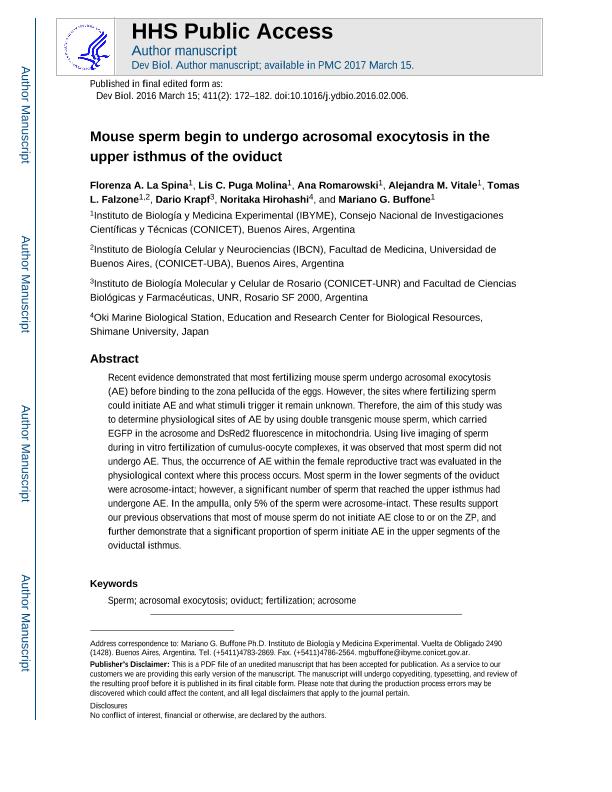Artículo
Mouse sperm begin to undergo acrosomal exocytosis in the upper isthmus of the oviduct
la Spina, Florenza Antonella ; Puga Molina, Lis del Carmen
; Puga Molina, Lis del Carmen ; Romarowski, Ana
; Romarowski, Ana ; Vitale, Alejandra Mariel
; Vitale, Alejandra Mariel ; Falzone, Tomas Luis
; Falzone, Tomas Luis ; Krapf, Dario
; Krapf, Dario ; Hirohashi, Noritaki; Buffone, Mariano Gabriel
; Hirohashi, Noritaki; Buffone, Mariano Gabriel
 ; Puga Molina, Lis del Carmen
; Puga Molina, Lis del Carmen ; Romarowski, Ana
; Romarowski, Ana ; Vitale, Alejandra Mariel
; Vitale, Alejandra Mariel ; Falzone, Tomas Luis
; Falzone, Tomas Luis ; Krapf, Dario
; Krapf, Dario ; Hirohashi, Noritaki; Buffone, Mariano Gabriel
; Hirohashi, Noritaki; Buffone, Mariano Gabriel
Fecha de publicación:
15/03/2016
Editorial:
Elsevier
Revista:
Developmental Biology
ISSN:
0012-1606
e-ISSN:
1095-564X
Idioma:
Inglés
Tipo de recurso:
Artículo publicado
Clasificación temática:
Resumen
Recent evidence demonstrated that most fertilizing mouse sperm undergo acrosomal exocytosis (AE) before binding to the zona pellucida of the eggs. However, the sites where fertilizing sperm could initiate AE and what stimuli trigger it remain unknown. Therefore, the aim of this study was to determine physiological sites of AE by using double transgenic mouse sperm, which carried EGFP in the acrosome and DsRed2 fluorescence in mitochondria. Using live imaging of sperm during in vitro fertilization of cumulus-oocyte complexes, it was observed that most sperm did not undergo AE. Thus, the occurrence of AE within the female reproductive tract was evaluated in the physiological context where this process occurs. Most sperm in the lower segments of the oviduct were acrosome-intact; however, a significant number of sperm that reached the upper isthmus had undergone AE. In the ampulla, only 5% of the sperm were acrosome-intact. These results support our previous observations that most of mouse sperm do not initiate AE close to or on the ZP, and further demonstrate that a significant proportion of sperm initiate AE in the upper segments of the oviductal isthmus.
Palabras clave:
Acrosome Reaction
,
Sperm
,
Oviduct
,
Fertilization
Archivos asociados
Licencia
Identificadores
Colecciones
Articulos(IBR)
Articulos de INST.DE BIOLOGIA MOLECULAR Y CELULAR DE ROSARIO
Articulos de INST.DE BIOLOGIA MOLECULAR Y CELULAR DE ROSARIO
Articulos(IBYME)
Articulos de INST.DE BIOLOGIA Y MEDICINA EXPERIMENTAL (I)
Articulos de INST.DE BIOLOGIA Y MEDICINA EXPERIMENTAL (I)
Citación
la Spina, Florenza Antonella; Puga Molina, Lis del Carmen; Romarowski, Ana; Vitale, Alejandra Mariel; Falzone, Tomas Luis; et al.; Mouse sperm begin to undergo acrosomal exocytosis in the upper isthmus of the oviduct; Elsevier; Developmental Biology; 411; 2; 15-3-2016; 172-182
Compartir
Altmétricas



